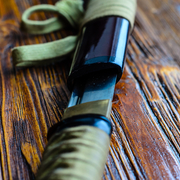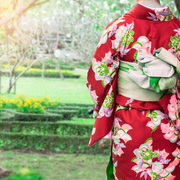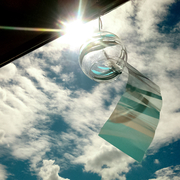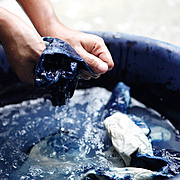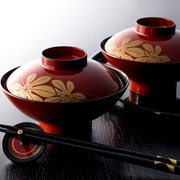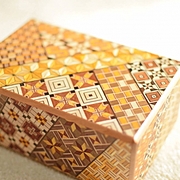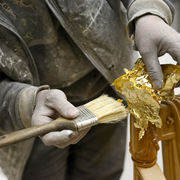Japanese Straw Crafts in Modern Age
New Year period is an occasion that you see more straw crafts like Shimenawa.
(decorative straw wreaths for new year displayed at the front door of houses or shops) than usual.
These days, Shimenawa is arranged and enjoyed in modern designs just like western wreaths so it can be displayed throughout the year.
What people really like about Neko Chigura is not only being able to see a cute cat face sticking out from the inside, but also its practical features that straw naturally has: breathability, thermal ability, and a sense of warmth coming from handmade.
Neko Chigura is now very popular among many cat owners and some of them stay on the waiting list to purchase.
Now, you are becoming a little familiar with straw crafts, aren’t you?
From now, let’s explore the world of straw crafts starting with the history and journey of how they have developed in Japan up to now.
History of Straw Crafts

The culture of straw craft has developed with rice farming.
Straw is agricultural byproduct consisting of the dry stalks of rice plants after rice grain and chaff have been removed.
Straw is used in many different forms such tools for everyday life, artistic ornaments for Shinto-style ceremonial occasions, toys, and crafts to name a few.
Straw is a high performing natural material in terms of breathability, thermal ability and shock absorption.
In addition, straw can be food for cows and horses, fuel to make hot water for bathing, or simply an eco-friendly biogradable material when decays.
With the great insulation ability of straw that gives coolness during summer and warmth during winter, straw has been used in many areas of traditional Japanese houses: roofing, part of wall clay as a reinforcement material, bedding.
You can tell that straw used to play a very important role that shaped Japanese culture.
Regional Straw Cultures in Japan

In the snowy regions such as Yamagata and Akita Niigata, straw was used in snowshoes called “Kanjiki” and snow-proof coats called “Mino.”
Straw was also used in sandals, gloves, hats in everyday life.
In addition, straw was used in egg packages called “Tamatsuto” and in wrapping material of fermented soy beans called “Natto.”
Natto was considered a food found by a happy coincidence that Bacillus subtilis (known also as the hay bacillus or grass bacillus that is Gram-positive bacterium) that naturally exist in straw were transferred to boiled soybeans inside straw bags and fermented.
Natto is one of the Japanese foods that have given significant influence on Japanese food culture up to now.
In addition, straw was used in many tools to improve the quality of life, for instance, pot stands called “Nabeshiki”, thermal containers for rice serving bowls called “Wara Izumi,” and backpacks called “Bandori” etc.
In some areas where silkworm farms were located, straw was used to make nests for silkworms called “Wara Mabushi” to help them make cocoon balls.
Also, straw was used in the lanthanum style of firefly cages called “Hotaru Kago” in which straw was knitted spirally.
Hotaru Kago was designed to simply enjoy illuminating lights of fireflies in the cage.
Watching fireflies’ lights through the beautifully designed Hotaru Kago is magnificent, and gives you a sense of total integration with the nature.
Enjoying the harmony with the nature is the essence of Japanese culture.
The excellence of straw works is not only their practical use and crafted designs, but also playfulness and artistic aspects, such as knitting straw with colored fabrics.
This cultural essence is still present in Shime Kazari (decorative straw rope for New Year.)
Shime Kazari is displayed at the front door to welcome and host “Toshi Gami sama (Kami = Shinto God of New Year) and to pray for safety and health of the family.
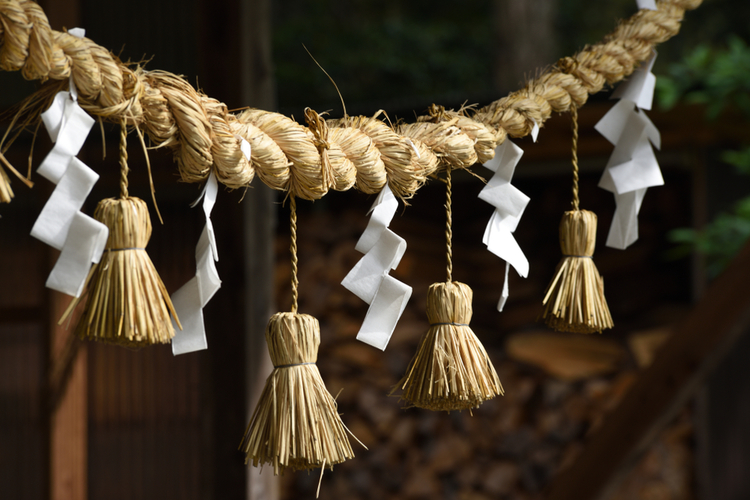
The origin of Shime Kazari goes back to the time of "Kojiki”*, Records of Ancient Matters (Japan's oldest historical record)” composed around early 8th century. (*Kojiki contains a myth related to Shime Kazari.)
In this myth, there was the Kami (Shinto Goddess) of the sun called Amaterasu Omikami who was once hiding in “Ama-no-Iwato (heavenly rock cave). “
(By lacking the goddess of sun, the earth was plunged into darkness and chaos.)
Then, eight million Shinto Gods called “Yaoyorozu no Kami” eventually persuaded her to leave the cave.
They put sacred enclosing ropes called “Shiri Kume Nawa” around the cave to keep out Amaterasu Omikami from the cave.
Now, let’s see how Shime Kazari is made.
The common way of knitting Shime Kazari is twisting from right to left with the large diameter portion on the right against the alter of Kami.
This concept is originated from the myths that the left side (from Kami’s viewpoint) is considered holly while right side (from Kami’s viewpoint) is considered casual.
Once straw is knitted into the form of rope, some other natural materials are added to Shime Kazari such as leaves of Shida plants called “Urajiro”, decorative rice paper called “Shide” for purifying negative vibes”, leaves called “Yuzuriha” for protecting the family and praying for prosperity of descendants, and seeds called “Daidai” for everlasting prosperity from generation to generation.
Interestingly, the designs of Shime Kazari truly vary depending on regions.

In western Japan, the major style of Shime Kazari is called "Gobo Jime”, which is displayed as straight and long as a burdock without reshaping.
Mostly Shime Kazari is displayed with the large diameter portion is put on the right side.
However, the meanings and ways of displaying vary depending on districts even within the same prefecture. For example, in Mie prefecture, Ise district displays it with the large diameter side on the left side.
In the eastern Japan, the majority of Shime Kazari is looped-shape just like a wreath called “Tama Kazari”.
There are more variations in Shime Kazari that are designed in the forms of “straw rice bag, crane, turtle, ladle, horse, jewel, snake” and so on.
The straw cultures in many regions emerged almost simultaneously throughout the county, while each regional culture was shaped with various thoughts and wishes of local people.
Straw crafts in animal shapes such as dogs and birds are also made in many regions.
When you look at these crafts, you would be impressed by the highly skilled craftsmanship and stylish designs as well as cuteness that makes you smile.
Current Straw Crafts
Back in old days, farmers used to knit straw crafts to earn cash during winter season where farming work was unavailable.
Straw crafts are the products of people’s wisdom and techniques that fully utilize rice plants after rice grain has been removed, which enrich our daily life, and these techniques have been passed on from generation to generation.
However, with the technology advancement in rice farming where rice plants are chopped into small pieces to make fertilizer, it is becoming harder to purchase long straw that is suitable for straw work.
For that reason, currently a few companies who manufacture and sell Shime Nawa and straw crafts grow rice plants exclusively for straw work.
Every year craftsmen who make grass sandals for traditional local festivals purchase straw from other regions.
Despite the challenges noted above, the functionalities of straw, beautiful craftwork, and the sense of warmth coming from handmade crafts are now getting more recognitions.
You can find straw crafts sold in special sales events of many department stores and in multi-brand shops.
While people are starting to recognize the excellence of straw material, the number of highly-skilled craft workers has been decreasing.
Having exploring the world of Japanese straw crafts together up to now, you may be becoming more aware that straw crafts are part of traditional Japanese culture: stylish designs evolved over time, craftsmanship that pays attentions to details and puts their soul into products.
The more you learn about straw crafts, the more you come to think that we should keep this culture alive.
You may be able to look at straw crafts exhibited at some cultural museums located in the regions where rice farming was (has been) active.
Please note that there are groups and workshops who are teaching traditional straw crafts making in various regions.
Why don’t you experience it to make your own straw craft for fun by actually seeing, touching, feeling, and smelling of real straw.
It may bring you a nostalgic feeling that reminds you good old days.


